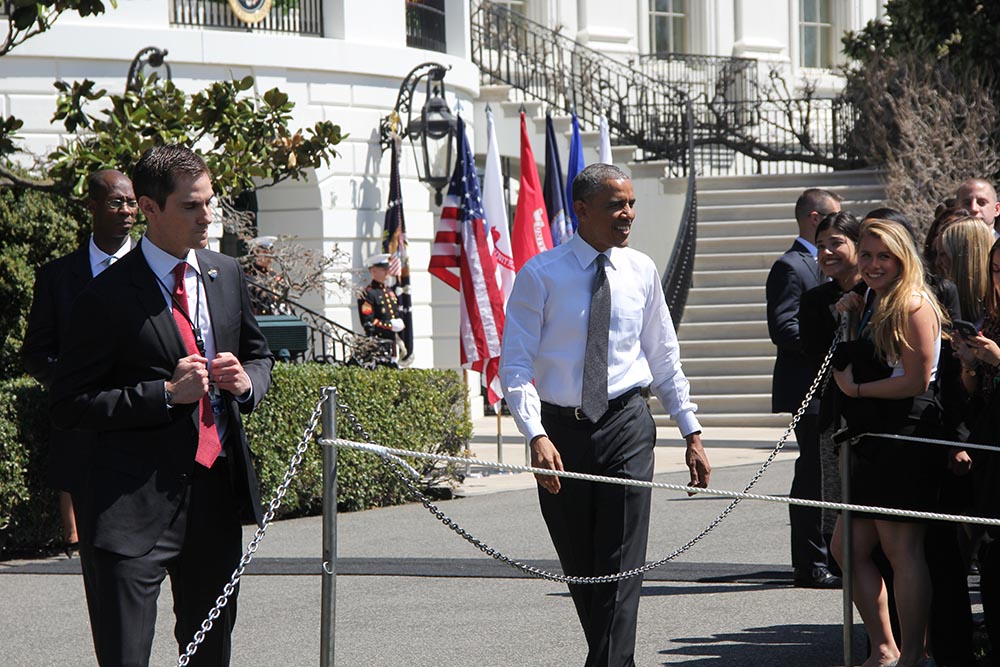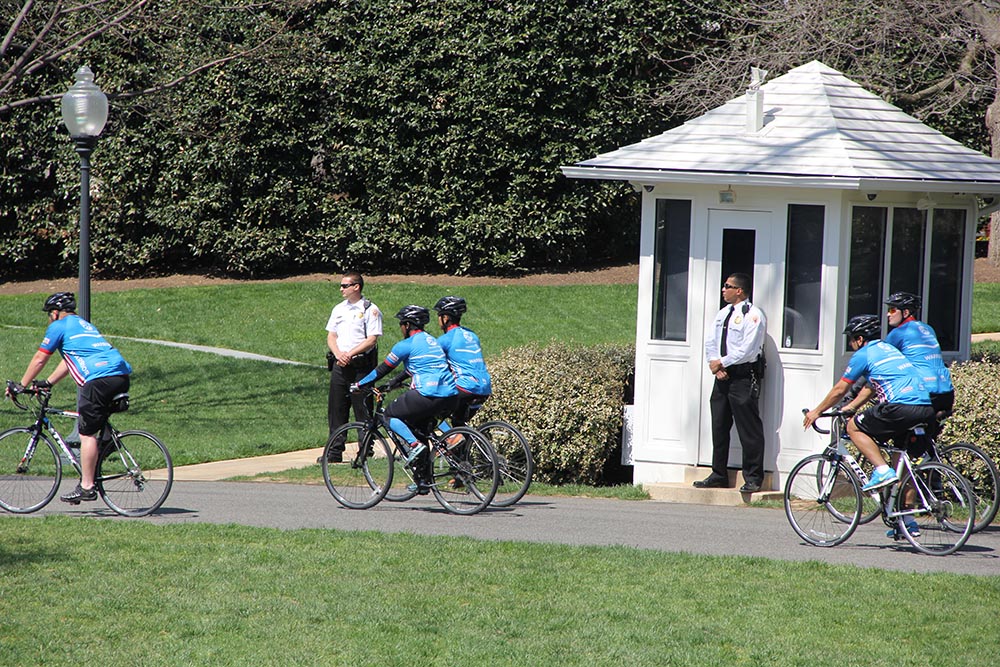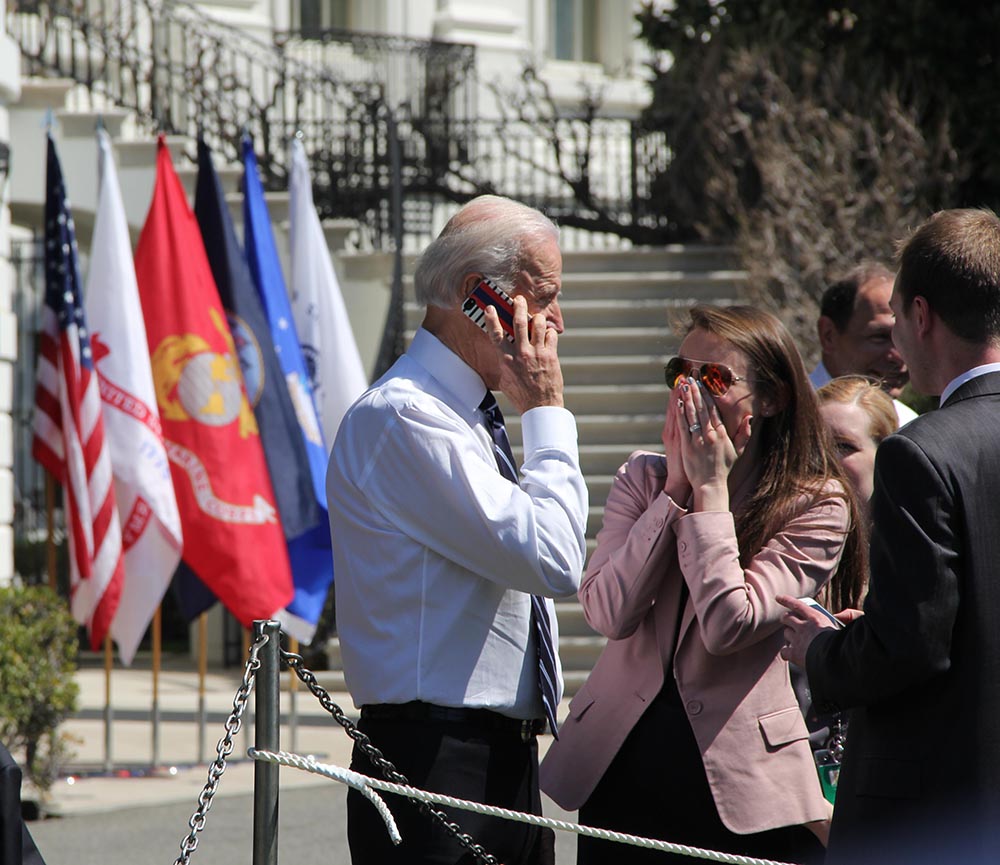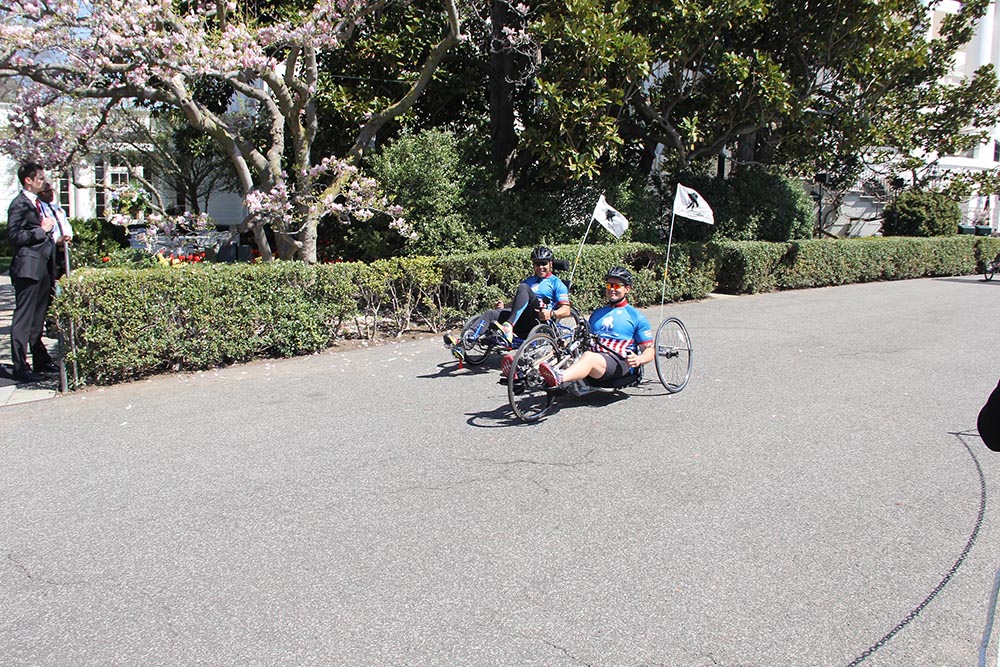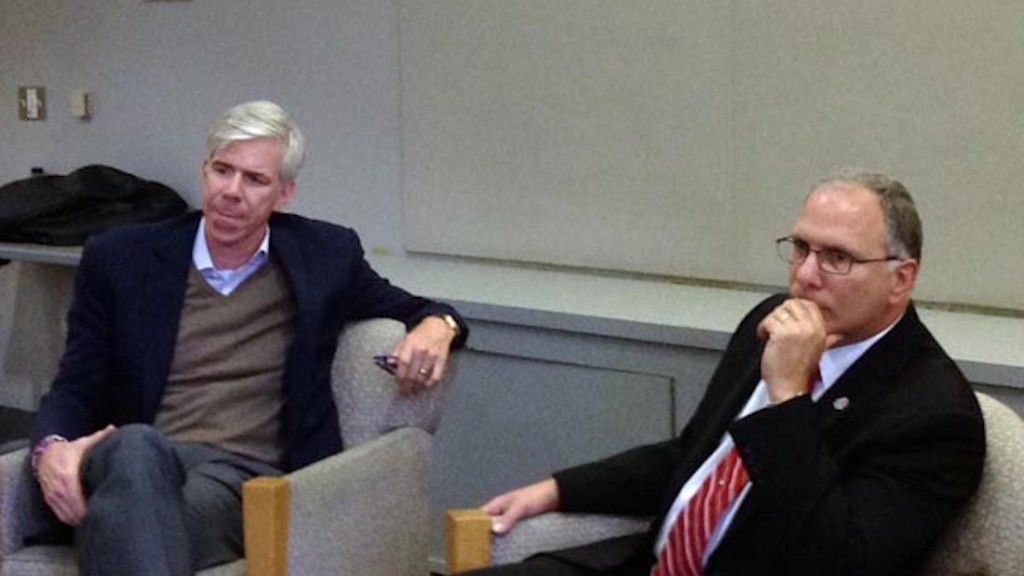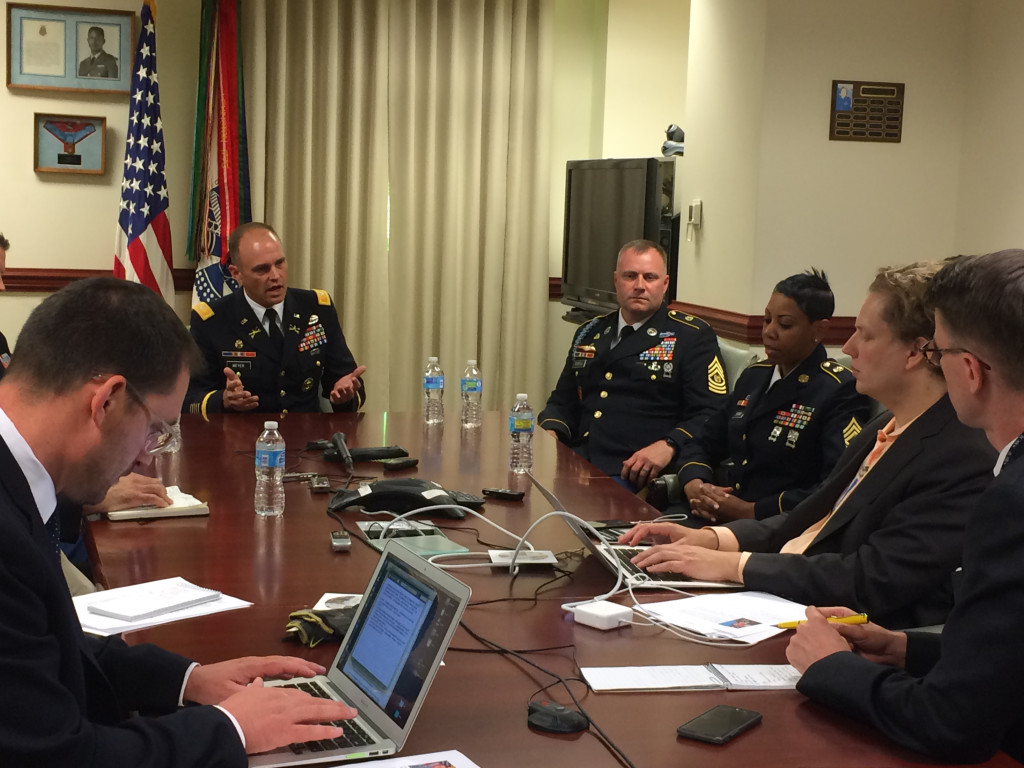
US Army Europe officers speaks to reporters at the Pentagon about their rotational training in Eastern Europe, Wednesday, July 22, 2015. (Amina Ismail/Medill NSJI)
Officers of the US Army’s 2nd Cavalry Regiment, currently stationed in Vilseck, Germany, stopped by the Pentagon last week to talk about their rotational training in Eastern Europe and the larger array of efforts in the region being held to reassure NATO allies.
Since Russian President Vladimir Putin’s annexation of Crimea from February 2014, and his increasingly aggressive actions near NATO’s stomping grounds, the Pentagon has been beefing up its military exercises and rotations in Central and Eastern Europe to ensure what US military officials say is the security and stability of its NATO allies.
“I can tell you that the countries that we are training with are concerned with Russia as a threat to the stability of Europe,” Army Colonel John V. Meyer III, commander of the 2nd Cavalry Regiment, told journalists at a roundtable. “We are working on strengthening the alliance. We want a strong Europe.”
The Obama administration’s European Reassurance Initiative was launched in June 2014 with a $1 billion budget for training and temporary rotations.
These rotations are less costly and less politically sensitive than permanently stationing troops in Europe because joint exercises and a temporary presence ensure the allied nation’s sovereignty and improve its military capabilities.
“It is not perceived at all that the US is trying to expand its influence,” Meyer said. “Our host nations, our allies helped sustain us.”
Lieutenant General Ben Hodges, commanding general of US Army Europe, hinted at the long-term goal for the army in a promotional video. “Being able to rotate units to come over to train, but also have an in-depth understanding of the culture, the history, the geography, the infrastructure… This is going to be a permanent part of how the army operates,” he said.
One of the things that proves a regular hindrance for US crisis response is sending hundreds or thousands of troops overseas who don’t know the people, language, culture, or terrain of the country where they’re expected to be fighting.
Meanwhile, local forces have little or no experience working with US forces, procedures, or practices. By cycling troops through a region, it gives local forces ample opportunity to practice with US forces, while giving a wide range of American forces at least a basic working familiarity with the area.
For more than a decade, the US and NATO have avoided deploying permanent troops and military equipment to NATO’s newer member states which, during the Cold War, were part of the Soviet bloc, or even the Soviet Union.
This has been avoided in part to minimize tensions and prevent friction with the Kremlin, and is in keeping with the 1997 Founding Act on Mutual Relations, Cooperation, and Security “to give concrete substance to their shared commitment to build a stable, peaceful, and undivided Europe.”
Apart from that more peaceful rationale, the US Army had actual wars to fight elsewhere anyway: Afghanistan and Iraq called for the majority of US troops to be in, going to, or coming from the Middle East and Central Asia.
Last month, Defense Secretary Ashton Carter announced that the army — for the first time since it downsized its presence in Europe — would store tanks, heavy weapons, and infantry combat vehicles in Eastern and Central Europe, a bold move that may be viewed as a violation of the essence of the treaty, which states that NATO members and Russia should not consider each other adversaries.
Carter’s decision was part of the European Reassurance Alliance and Operation Atlantic Resolve, a training program launched by the US Department of Defense in May.
Operation Atlantic Resolve is the European counterpart to the Pacific Pathways model introduced last fall. In September, the US Army Pacific deployed about 1,200 soldiers for the month-long Garuda Shield training exercise in Indonesia. This joint effort with the Indonesian military served as the pilot program, and was the first time the army deployed troops for rotational training exercises with multinational partners.
The move to expeditionary-style forces in many ways dates back to the end of the Cold War, which marked the beginning of a steady decline of US Army presence in Eastern Europe and pre-positioned Overseas Material Configured to Unit Sets (POMCUS). The last US tanks, stationed in Grafenwöhr, Germany, were pulled out of Europe in March 2013, just one year before Russian tanks began moving into Crimea.
After heavy speculation and rumors about the US decision to store such equipment, and before Carter’s official announcement, Putin responded at an arms fair west of Moscow.
“More than 40 new intercontinental ballistic missiles able to overcome even the most technically advanced anti-missile defense systems will be added to the make-up of the nuclear arsenal this year,” he said.
Considering Russia’s satellite nuclear warning system will be out of service until November, this addition to Putin’s arsenal — and his public announcement — leaves the rest of the world hoping he will become neither brash nor desperate enough to make use of it.
Under Operation Atlantic Resolve, smaller companies of about US 100 soldiers are deployed to the Baltic States, while larger battalions of troops deploy to Poland to engage in rotational training exercises with allied armed forces. These so-called Regionally Aligned Forces are units that rotate into the country without bringing equipment, but instead use the European Activity Set, which contains a combined-arms, battalion-sized group of vehicles, and pre-positioned equipment permanently stationed in the US Army’s training area in Grafenwöhr — the exact location where only two years ago soldiers marked the end of an era, as the last US tanks withdrew from European soil.
The current US operations throughout Europe have a Cold War precedent. NATO’s annual REFORGER — Return of Forces to Germany — exercises filled a similar role: proving to both NATO and Russia that the US is capable of moving a large, decisive combat force quickly into the region in the event of war.
According to the official fact sheet, “Operation Atlantic Resolve will remain in place as long as the need exists to reassure our allies and deter Russia from regional hegemony.”
But is this rotational presence really going to send a clear and strong message to the Kremlin? Magnus Nordenman, an analyst with the Atlantic Council, thinks it sends “somewhat of a message.”
“The preference is to have permanently based forces, but if we can’t have that, then certainly rotations are better than nothing,” he told VICE News.
Both Marine General Joseph Dunford, the nominee to be chairman of the Joint Chiefs of Staff, and his prospective vice chairman, General Paul Selva, bring not only experience in strategic mobility, but also described Russia as a greater threat than China, North Korea, or Iran during their confirmation hearings, and encouraged deployment of heavy weapons in Europe to defend NATO allies.
Secretary of State John Kerry, who initially disagreed with Dunford and Selva, was alarmed by Putin’s comments. “Nobody should hear that kind of announcement from a leader of a powerful country and not be concerned about what the implications are,” Kerry said.
The short-term objective of the 2nd Cavalry Regiment’s training now seems obvious. “It provides us with operational mobility to maneuver throughout the alliance, and that is an incredible capability that we have inside Europe now,” Colonel Meyer said.
“A lot has been said over the last weeks about whether or not Russia is a threat, and what I can say is, I am training the formation to deal with any of the threats we can be faced with,” he added.
That same type of training has already occurred in the Pacific. Garuda Shield, along with the other training operations in Malaysia and Japan, were framed as a “Pacific Rebalance” — the current bureaucratic moniker of the Obama administration’s 2013 Pacific Pivot. The official Army Pacific Command website calls these efforts a “tangible demonstration of US commitment to Indo-Asia Pacific region security and stability.”
This operation, like its European equivalent, aims to train US forces with allied forces and familiarize the troops with the region.
Interestingly, the US Army is also focused on increasing its maritime and expeditionary capabilities, and appears to be reassessing its roots and fundamentally rethinking its structure and responsibilities.
With the implementation of this new, lighter-footprint form of power projection, some of the highest-ranking army officers envision a smaller, more flexible force capable of doing the strategic job of a much larger force. European commander Hodges would like “30,000 soldiers [to] achieve the strategic effect of 300,000 soldiers.”
“I don’t think he was being literal,” army spokesman Joseph Buccino told VICE News. “In a literal sense, it is impossible to replicate 30,000 [troops] with 300,000.”
But at least one commander sounded a word of caution.
“Rotating presence is no substitute for permanent forward presence,” said General Philip Breedlove, commander of the US European Command, which controls all military forces in that theater, in a Pentagon press briefing in April. But, he added: “Genuinely and fully funded rotational presence can play an important role in helping meet the requirements in our theater.”
This is ultimately the rub. This sort of “virtual presence” is a good way to extend limited peacetime resources, but is still just a placeholder for non-existent troops that will be sorely needed should conventional deterrence fail and war break out.




